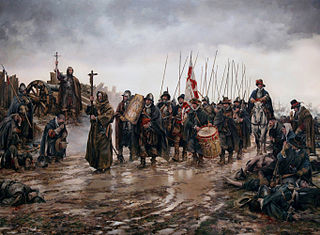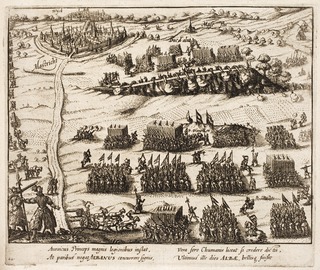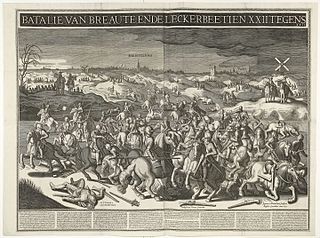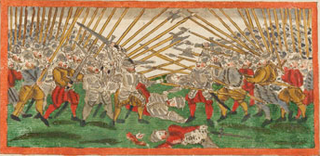 W
WThe Siege of Aachen took place in late August 1614, when the Spanish Army of Flanders, led by Ambrogio Spinola, 1st Marquis of the Balbases, marched from Maastricht to Germany to support Wolfgang Wilhelm, Count Palatine of Neuburg, during the War of the Jülich Succession. Despite its status as a free imperial city, Aachen was under the protection of John Sigismund of Brandenburg, Neunburg's ally, and then rival, in the battle for the United Duchies of Jülich-Cleves-Berg. In 1611, the Protestant population of Aachen had revolted against the Catholic city council and had seized power. When the Holy Roman Emperor Rudolf II, observing the Peace of Augsburg, had ordered the previous state to be restored, the Protestants had allied themselves with the Margraviate of Brandenburg. The unexpected arrival of a Spanish army at the gates of the city, however, caused the Protestants to lose courage and surrender Aachen to Spinola. A Catholic garrison was installed and a process of re-Catholicization began.
 W
WThe Sack of Antwerp, often known as the Spanish Fury at Antwerp, was an episode of the Eighty Years' War. It is the greatest massacre in Belgian history.
 W
WThe recapture of Bahia was an Imperial Spain military expedition in 1625 to retake the city of Salvador da Bahia in Brazil from the forces of the Dutch West India Company (WIC).
 W
WThe Battle of Borgerhout was a battle during the Eighty Years' War, of the Spanish Army of Flanders led by Alexander Farnese, Prince of Parma, upon a fortified camp at the village of Borgerhout, near Antwerp, where several thousand French, English, Scottish, and Walloon soldiers in service of the recently created Union of Utrecht were stationed. It took place during the reconquest by the armies of Philip II of Spain of the Burgundian Netherlands, whose different provinces had united in 1576 under the Pacification of Ghent to drive out the foreign troops and to grant religious liberty to Protestants.
 W
WThe Capture of Brielle by the Watergeuzen, on 1 April 1572 marked a turning point in the uprising of the Low Countries against Spain in the Eighty Years' War. Militarily the success was minor as the port of Brielle was undefended, but it provided the first foothold on land for the rebels at a time when the rebellion was all but crushed, and it offered the sign for a new revolt throughout the Netherlands which led to the formation of the Dutch Republic.
 W
WThe Battle of Dahlen was fought on April 23, 1568, between a Dutch rebel army led by Jean de Montigny, Lord of Villers, and a Spanish army commanded by Sancho Dávila y Daza. As a part of William of Orange's planned invasion, the Dutch rebels were trying to conquer the town of Roermond when the arrival of the Spanish force compelled them to withdraw. Dávila pursued the retreating force and inflicted a defeat upon Villers near the small town of Dahlen. The survivors of this encounter sought refuge under the walls of Dahlen, where the Spanish infantry finally defeated them. This battle is sometimes considered the official start of the Eighty Years' War.
 W
WThe Taking of Diest was a successful surprise assault on the town of Diest, in the Duchy of Brabant, during the Dutch Revolt.
 W
WThe Siege of Eindhoven, also known as the Capture of Eindhoven of 1583, took place between 7 February and 23 April 1583 at Eindhoven, Duchy of Brabant, Spanish Netherlands during the Eighty Years' War and the Anglo-Spanish War (1585–1604). On 7 February 1583 a Spanish force sent by Don Alexander Farnese, Governor-General of the Spanish Netherlands, commanded by Karl von Mansfeld and Claude de Berlaymont, laid siege to Eindhoven, an important and strategic city of Brabant held by Dutch, Scottish, and French soldiers under the States' commander Hendrik van Bonnivet. After three months of siege, and the failed attempts by the States-General to assist Bonnivet's forces, the defenders surrendered to the Spaniards on 23 April.
 W
WThe Miracle of Empel was an unexpected Spanish victory on 8 December 1585 near Empel, in the Netherlands, as part of the Eighty Years' War, in which a surrounded Spanish force miraculously won against an enemy who exceeded them in number.
 W
WThe English Fury at Mechelen or the Capture of Mechelen was an event in the Eighty Years' War and the Anglo–Spanish War on April 9, 1580. The city of Mechelen was conquered by Calvinist forces from Brussels which included a large contingent of English mercenaries. The city was brutally sacked and its religious treasures destroyed or plundered.
 W
WThe Battle of Fleurus of August 29, 1622 was fought in the Spanish Netherlands between a Spanish army, and the Protestant forces of Ernst von Mansfeld and Christian of Brunswick during the Eighty Years' War and Thirty Years' War. The bloody struggle left the Protestants mangled and the Spanish masters of the field, but unable to block the enemy's march.
 W
WThe "French Fury" was a failed attempt by Francis, Duke of Anjou, to conquer the city of Antwerp by surprise on 17 January 1583.
 W
WThe Battle of Gembloux took place at Gembloux, near Namur, Low Countries, between the Spanish forces led by Don John of Austria, Governor-General of the Spanish Netherlands, and a rebel army composed of Dutch, Flemish, English, Scottish, German, French, and Walloon soldiers under Antoine de Goignies, during the Eighty Years' War and the Anglo-Spanish War (1585–1604). On 31 January 1578 the Spanish cavalry commanded by John's nephew, Don Alexander Farnese, Prince of Parma, after pushing back the Netherlandish cavalry, attacked the Netherlandish army, causing an enormous panic amongst the rebel troops. The result was a crushing victory for the Spanish forces. The battle hastened the disintegration of the unity of the rebel provinces, and meant the end of the Union of Brussels.
 W
WThe Battle of Heiligerlee was fought between Dutch rebels and the Spanish army of Friesland. It was the first Dutch victory during the Eighty Years' War.
 W
WAfter the Battle of Heiligerlee, the Dutch rebel leader Louis of Nassau failed to capture the city of Groningen. Louis was driven away by Fernando Álvarez de Toledo, Duke of Alba and defeated at the Battle of Jemmingen on 21 July 1568.
 W
WThe Battle of Jodoigne was fought on 20 October 1568 between Spanish and Dutch Rebel forces.
 W
WThe Battle of Lekkerbeetje or Lekkerbeetken was a cavalry duel fought by pre-arrangement on Vughterheide near 's-Hertogenbosch, North Brabant, between 22 Brabantine cavalrymen loyal to Albert VII, Archduke of Austria, garrisoned in 's-Hertogenbosch, and 22 French cavalrymen serving in the army of the Dutch Republic.
 W
WThe siege of Lingen of 1605 took place between 10 August and 19 August 1605, at Lingen, District of Emsland, Lower Saxony, between Spain and the United Provinces, during the Eighty Years' War. Prince Maurice of Nassau tried to preserve Lingen at all costs. The Dutch garrison led by Captain Maerten Cobben, expecting to be aided by Maurice's army, held out for nine days, but were finally forced to surrender. The siege was part of Spinola's successful campaign of 1605-1606.
 W
WThe Battle of the Lippe was a cavalry action fought on 2 September 1595 on the banks of the Lippe river, in Germany, between a corps of Spanish cavalry led by Juan de Córdoba and a corps of Dutch cavalry, supported by English troops, led by Philip of Nassau. The Dutch statholder Maurice of Nassau, taking advantage of the fact that the bulk of the Spanish army was busied in operations in France, besieged the town of Groenlo in Gelderland, but the elderly governor of the citadel of Antwerp, Cristóbal de Mondragón, organized a relief army and forced Maurice to lift the siege. Mondragón next moved to Wesel, positioning his troops on the southern bank of the Lippe river to cover Rheinberg from a Dutch attack. Maurice aimed then, relying on his superior army, to entice Mondragón into a pitched battle, planning to use an ambush to draw the Spanish army into a trap. However, the plan was discovered by the Spanish commander, who organized a counter-ambush.
 W
WThe siege of Mons of 1572 took place at Mons, capital of the County of Hainaut, Spanish Netherlands, between 23 June and 19 September 1572, as part of the Eighty Years' War, the Anglo-Spanish War (1585–1604), and the French Wars of Religion. In the spring of 1572, after the capture of Valenciennes by a Protestant force under Louis of Nassau, the Dutch commander continued with his offensive and took Mons by surprise on 24 May. After three months of siege, and the defeats of the armies of Jean de Hangest, seigneur d'Yvoy and Genlis, and William the Silent, Prince of Orange (Dutch: Willem van Oranje), by the Spanish army led by Don Fernando Álvarez de Toledo, Duke of Alba, Governor-General of the Spanish Netherlands, and his son, Don Fadrique de Toledo, Louis of Nassau's forces, isolated and without any hope of help, surrendered Mons to the Duke of Alba on 19 September.
 W
WIn the Battle of Mookerheyde, Spanish forces defeated Dutch forces composed of German mercenaries on 14 April 1574 during the Eighty Years' War near the village Mook and the river Meuse not far from Nijmegen in Gelderland. Two leaders of the Dutch forces, brothers of William the Silent, were killed: Louis of Nassau and Henry of Nassau-Dillenburg.
 W
WThe Battle of Nieuwpoort, took place on 2 July 1600 during the Eighty Years War and the Anglo-Spanish war in the dunes near Nieuwpoort. The Anglo-Dutch companies met the Spanish veterans head on which although their left flank nearly broke were able to assail them with both infantry and cavalry. The Spanish gradually scattered in all directions and left their guns on the field.
 W
WThe Assault on Nijmegen occurred on the night of 10 August 1589, involving troops of the mercenary Martin Schenck von Nydeggen against the small garrison and some citizens at the city of Nijmegen.
 W
WThe Battle of Noordhorn, fought on 30 September 1581, was a pitched battle of the Dutch Revolt, fought between a Spanish army commanded by Colonel Francisco Verdugo – consisting of Walloon, German, Spanish, and Albanian soldiers – and a Dutch States rebel army under the Englishman John Norreys – comprising English, Scottish, Dutch, and Walloon troops – in the province of Groningen. In 1580, the Dutch stadtholder of Groningen, George van Lalaing, Count of Rennenberg, had shifted its allegiance from the Dutch to the Spanish side. This opened a new front at the back door of the Dutch Republic, forcing the States-General to dispatch forces to the north. That year the Dutch, under the leadership of John Norreys, succeeded in relieving the town of Steenwijk. In July 1581, Rennenberg died and was replaced by the Spaniard Francisco Verdugo, whose arrival in Groningen with reinforcements changed the situation. On 30 September Verdugo forced Norreys to give battle using a strategy of attrition.
 W
WThe Battle of Oosterweel took place on 13 March 1567 near the village of Oosterweel, near Antwerp, in present-day Belgium, and is traditionally seen as the beginning of the Eighty Years' War. A Spanish mercenary army surprised a band of rebels and killed or captured almost all of them.
 W
WThe Battle of Rijmenam was a battle fought in the early stages of the Eighty Years' War between the forces of the States-General of the Netherlands and those of the Spanish Governor-General of the Habsburg Netherlands, Don Juan de Austria, on 31 July 1578, near Rijmenam in present-day Belgium. The Spanish forces were dealt a strategic defeat.
 W
WThe siege of Sluis of 1587 took place between 12 June and 4 August 1587, as part of the Eighty Years' War and the Anglo-Spanish War (1585–1604). Its capture by the Spanish formed a significant advance towards the Enterprise of England.
 W
WThe Spanish Fury at Mechelen was an event in the Eighty Years' War on October 2, 1572 in which the city of Mechelen was conquered by the Spanish army and brutally sacked.
 W
WThe Battle of Steenbergen, also known as the Capture of Steenbergen of 1583, took place on 17 June 1583 at Steenbergen, Duchy of Brabant, Spanish Netherlands. This was an important victory for the Spanish Army of Flanders led by Don Alexander Farnese, Prince of Parma, Governor-General of the Spanish Netherlands, over the French, English, and Dutch forces led by the French Marshal Armand de Gontaut, Baron de Biron, and the English commander Sir John Norreys, during the Eighty Years' War, the Anglo-Spanish War (1585–1604), and in the context of the French Wars of Religion. The victory of the Spaniards ended the Treaty of Plessis-les-Tours, and Francis, Duke of Anjou (French: François de France), left the Netherlands in late June.
 W
WThe Battle of Turnhout also known as the Battle of Tielenheide was a military engagement which took place on 24 January 1597 in the border area between the Northern and Southern Netherlands at Turnhout during the Eighty Years' War and the Anglo-Spanish War (1585–1604).
 W
WThe Battle of Werl occurred between 3–8 March 1586, during a month-long campaign in the Duchy of Westphalia by mercenaries fighting for the Protestant (Calvinist) Archbishop-Prince Elector of Cologne, Gebhard Truchsess von Waldburg.
 W
WThe Battle of Zutphen was fought on 22 September 1586, near the village of Warnsveld and the town of Zutphen, the Netherlands, during the Eighty Years' War. It was fought between the forces of the United Provinces of the Netherlands, aided by the English, against the Spanish. In 1585, England signed the Treaty of Nonsuch with the States-General of the Netherlands and formally entered the war against Spain. Robert Dudley, Earl of Leicester, was appointed as the Governor-General of the Netherlands and sent there in command of an English army to support the Dutch rebels. When Alessandro Farnese, Duke of Parma and commander of the Spanish Army of Flanders, besieged the town of Rheinberg during the Cologne War, Leicester, in turn, besieged the town of Zutphen, in the province of Gelderland and on the eastern bank of the river IJssel.